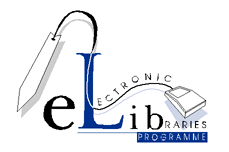Internet Archaeology
- Project web site
- http://intarch.ac.uk/
- Programme area
- Electronic Journals
- Contact details
- Dr Michael Heyworth, Deputy Director & Information Officer
Council for British Archaeology, Bowes Morrell House, 111 Walmgate, YORK, YO1 2UA
Phone: 01904 671417 Fax: 01904 671384
Email: m.heyworth@dial.pipex.comJudith Winters
Internet Archaeology Office, Department of Archaeology, University of York, The King's Manor, YORK, YO1 2EP
Phone: 01904 433955 Fax: 01904 433939
Email: editor@intarch.ac.uk
Project description
as of May 8th 1997
Introduction
This project in the Electronic Libraries Programme (eLib) has established an international electronic journal for archaeology. The journal is produced, disseminated and available to all via the Internet.
Description
The journal publishes the results of archaeological research, including excavation reports (text, photographs, data, drawings, reconstructions, diagrams, interpretations), analyses of large data sets along with the data itself, visualisations, programs used to analyze data, and applications of information technology in archaeology: for example, geographical information systems and computer modelling.
Conventional publication via the printed page cannot do justice to the rich diversity of archaeological information. Electronic publication, by contrast, offers opportunities to overcome these difficulties. The journal is fully-refereed. It sets a high academic standard. Contributions are provided by archaeologists throughout the world, and the journal is aimed at an international audience.
Key deliverables
The key deliverables for the project are as follows:
- a regular electronic journal
- a detailed description of the process of establishing and managing an electronic journal
- definition of a suite of access and navigation tools that will allow the readers to use the journal
- a contribution to cultural change through the increased use of electronic media
The first issue of the journal was mounted on the Internet in September 1996, and further issues appear regularly.
Participants
The University of York acts as the host for the project. The project's Managing Editor, Judith Winters, is based in the University's Department of Archaeology and is a staff member of the University. The journal is made available via a network server linked to the main University campus computer network under the supervision of the University Computing Service.
The Council for British Archaeology (CBA) acts as the publisher of the journal. The Council was founded in 1944 and is both an educational charity and a company limited by guarantee. It is primarily a liaison body made up of over 400 archaeological organisations and 3000 individual members. It works to advance the study and care of Britain's historic environment, and to improve public awareness of Britain's past. Three of its focal areas of activity are education, information and publication.
The British Academy, founded in 1901, is the learned society which has responsibility by Royal Charter for promoting advanced work in all the humane disciplines. Among these is archaeology. It has supported much archaeological fieldwork, publications of archaeological research including study of archaeological collections and excavation reports, and supports Schools and Institutes abroad.
The other consortium members are all UK universities with major archaeology departments (Durham, Glasgow, Oxford and Southampton). Together with the University of York, they contribute the specific expertise of individuals from within their archaeology departments.

